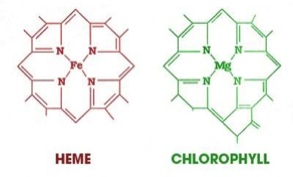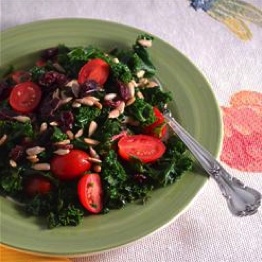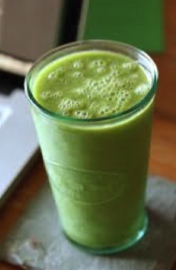News and Notes from The Johnson Center
Green = Good Nutrition
JCCHD | Wed, August 14, 2013 | [Family and Food]
Green fruits and vegetables are some of the healthiest foods to eat. They are full of nutrients and have a variety of benefits. One of the most underrated nutrients is chlorophyll. You may recall that chlorophyll gives plants a green color and converts sunlight into energy. You may not know that chlorophyll acts like hemoglobin for the plant. Hemoglobin carries oxygen from our lungs to the rest of our body by releasing and taking up iron. Chlorophyll uses magnesium as a cofactor for the same process (see molecular structure below). [1]
 This molecular structure makes chlorophyll very, very useful. Research suggests that it leads to increased red blood cell production and iron in the blood.1 Moreover, the magnesium is easily released from this molecular core. Magnesium deficiency is common and is linked to inflammation. [2] Additionally, some research suggests that magnesium reduces hyperactivity in children with ASD who are also taking a high dose of vitamin B6. [3]
This molecular structure makes chlorophyll very, very useful. Research suggests that it leads to increased red blood cell production and iron in the blood.1 Moreover, the magnesium is easily released from this molecular core. Magnesium deficiency is common and is linked to inflammation. [2] Additionally, some research suggests that magnesium reduces hyperactivity in children with ASD who are also taking a high dose of vitamin B6. [3]
Other Green Nutrients
Phytochemicals also contribute to the green color. Among them are apigenin and luteolin. All phytochemicals act like antioxidants, which eliminate cancer-causing free radicals in the body and reduce DNA damage. Apigenin is one of the few phytochemicals that has oxidative properties that surpass Vitamin C. Additionally, apigenin is known to trigger the suicide mechanism in cancer cells. [4] Luteolin is unique as well. In addition to its antioxidant properties, it has specific capabilities which inhibit pro-inflammatory chemicals rather than just reducing inflammation. [5]
Green fruits and vegetables are also high in fiber, calcium, and vitamin C. This blend of nutrients maximizes health benefits.
• Fiber is good for regulating the digestive system.
• Calcium is essential for healthy bones and muscular function.
• Vitamin C is a powerful antioxidant that is known to boost the immune system and reduce the risk of cancer.
Getting Your Child to Go Green
The “Eat the Rainbow” approach is effective when it comes to getting children to meet their daily requirement of fruits and vegetables. The goal is to eat one food item from each color of the rainbow per day. The tactic is successful and is implemented by healthy eating initiatives throughout the country.
Need some more ideas? Here are a few other ways to encourage healthy food habits:
• Use their imagination. Use analogies with your child’s favorite animal or character to your advantage. If it is a car, explain that fruits and vegetables are like gasoline for humans. You may add that they need to eat a certain number of veggies (i.e. broccoli florets) to win the big race.
• One Bite Rule. Children need to be exposed to a new food many times before it is accepted. Encourage your child to try a mouthful of a rejected food each time it is served. Once it is more familiar, your child is more likely to eat it.
• Reinforce good behavior. Decrease picky eating by creating positive experiences. Reward your child each time they take a bite of a rejected food. Stickers work well. Try not to use candy or other sweets as a reward.
Get a mouthful and check off two colors with this green/red recipe.
Kale Salad adapted from http://www.allrecipes.com

Ingredients:
• 1/2 cup lemon juice
• 1 tablespoon grapeseed oil
• 1 tablespoon olive oil
• 1 teaspoon natural sugar
• 1/2 teaspoon salt
• 1/4 teaspoon ground black pepper
• 1 bunch kale, cut into bite-size pieces
• 1 large tomato, seeded and diced
• 1/2 cup roasted sunflower seeds
• 1/2 cup dried cranberries
Directions:
Whisk lemon juice, oils, sugar, salt, and black pepper in a large bowl. Add kale, tomato, sunflower seeds, and cranberries; toss to combine.
Try this slushy green goodness.
Limeade Smoothie Recipe from http://www.withstyleandgraceblog.com

Ingredients:
• 1/2 cucumber, sliced
• 1/2 avocado
• 2 handfuls baby spinach
• 3-4 limes, peeled (adjust to desired amount)
• 1/2 teaspoon cinnamon
• Honey or agave to taste
• 6-8 ice cubes
Directions:
In blender, add cucumber, avocado, spinach, lime, cinnamon, honey, ice and blend on high until smooth. (Note: Add about 1/2 cup of cold water if it is too thick).
Article Resources:
1 http://www.hippocratesinst.org/well-being/chlorophyll
2 http://www.webmd.com/vitamins-and-supplements/lifestyle-guide-11/supplement-guide-magnesium
3 http://www.autism-society.org/living-with-autism/treatment-options/summary-of-biomedical.html
4 http://www.luteolin.com/apigenin.html
5 https://www.thieme-connect.com/ejournals/abstract/10.1055/s-0028-1088314



